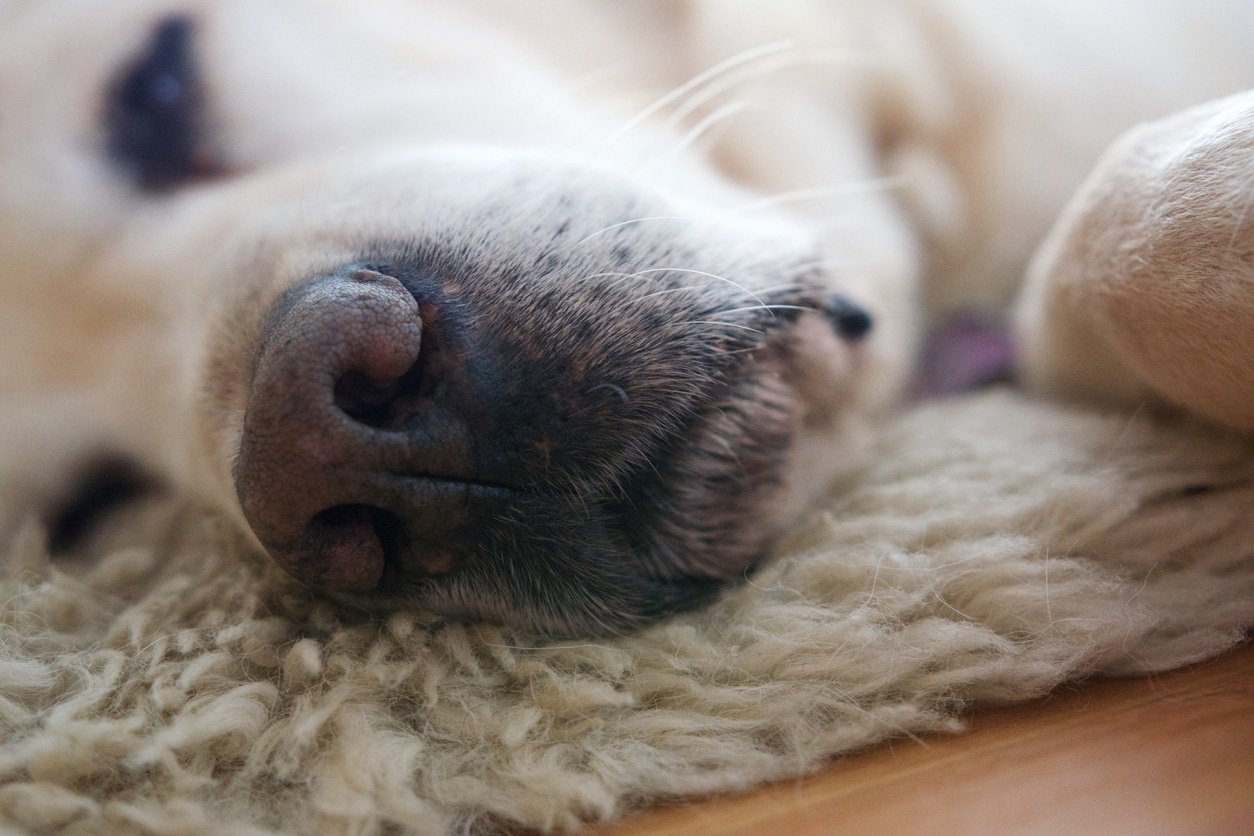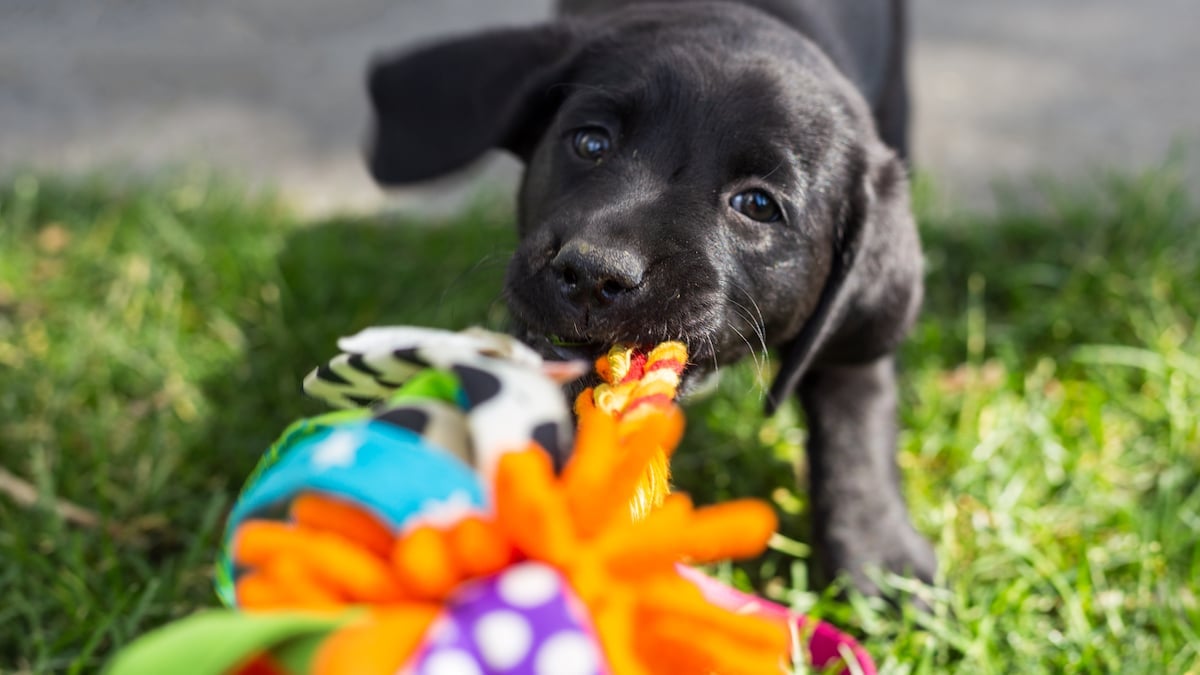
You may already know the Labrador Retriever as a high-energy, water-loving family dog. You might also feel like you see them everywhere. That’s no coincidence because the Labrador Retriever is one of the most popular dogs in the UK (and in much of the world). Read on to learn more about this easy-going dog breed, from their hunting dog history to how to care for your very own Lab best friend, and decide whether a Labrador Retriever dog is right for you.
Breed Characteristics
Key
- Low
- Medium
- High
- Origin: England, with ancestors from Newfoundland
- Size:
- Weight: 25-36 kilograms
- Activity level:
- Barking/howling level:
- Good with dogs: yes
- Good with kids: yes
- Good with cats:
- Shedding:
- Shedding: Seasonal
- Grooming level:
- Training level:
Labrador Retriever Breed Appearance
A Labrador Retriever dog has a dense, short-to medium-length coat, with a wide head. As a consummate water dog, a Lab’s webbed toes help them move through the wet stuff, and their rudder-like otter tail is great for swimming (and knocking things off your coffee table). Their foot webbing also helps them stay comfortable in colder climates, forming a “snowshoe” that keeps snow and ice from getting stuck between their toes.
Labrador Retrievers are born with a variety of colourings, including the yellow Lab, chocolate Lab, and black Lab. The silver Labrador Retriever is a dilute variant of the chocolate Lab, with a rare greyish colouring and striking blue eyes. Although it sounds like it, a “golden Lab” is not a colouring of a Labrador Retriever and is instead a crossbreeding of the Golden Retriever and a true Lab. Neither the silver nor golden colours are accepted by the Kennel Club.
Within the Lab breed, there are two distinct body types. The field or working variety (also referred to as the “American” type) tends to have lighter bones, a longer and less dense coat, a narrower head, and a longer muzzle. They also tend to have more energy and be higher-strung. This is no accident, as these Labs are built to work.
The “English” or show variety of Labrador Retriever tends to have shorter legs, a denser coat, and a broad head. This variety is better suited to be a family pet.
As far as grooming goes, a Labrador Retriever dog will usually shed twice a year, or year-round in temperate climates. Much like other dogs with a double coat, weekly brushing (or daily during shedding months) should be enough to prevent that dreaded blowout of the undercoat.

Labrador Retriever Personality
The Labrador Retriever was bred to be friendly, both toward humans and other dogs. To complement that gentle nature, their working history gives them a high-energy, fearless, enthusiastic personality.
Labs are curious and intelligent, which means they do well as service dogs, but this can mean that your single-minded Lab is more likely to escape or suddenly disappear, most likely having followed something interesting (squirrel?). This is why it’s important to keep your dog’s microchip information up to date and make sure they wear a collar with a tag.
Ideal Environment for a Labrador Retriever
A Labrador Retriever dog will need plenty of exercise and outdoor time. And, as their name implies, they love to retrieve. The best home for a Lab will be one with a big backyard or space nearby for a long game of fetch. With their sweet personalities and love of play, these dogs are a popular breed for an active family.
Ideal Human for a Labrador Retriever
The ideal human companion for a Labrador Retriever likes to play just as much as their dog. This can mean long walks and runs, swimming, or tossing a ball around.
However, the Lab’s history as a working dog also means that daily walks for exercise aren’t enough. Trick training, puzzle toys, and other mentally challenging games like hide and seek will help keep your Lab happy.
Labrador Retriever Training
With consistent positive reinforcement, a lab will excel with basic obedience training and soon be ready to move on to more complicated skills. You may still consider professional dog training for the early days though. Labs are known to be a little distractible. This can also be managed with plenty of mental and physical exercise, including teaching your lab new tricks in quiet environments where they can focus.
With their talent for learning and easygoing nature, Labrador Retrievers make excellent service dogs. Labs serve as companions to people with illnesses or vulnerabilities and can do complex tasks like rolling a person into the recovery position or activating an emergency communication device.
According to Guide Dogs for the Blind, Labs are one of the most successful guide dogs. This champion smeller can even work in search and rescue and is especially suited to more challenging work, such as water rescue. Labrador Retrievers are true heroes of the dog world.

Labrador Retriever Grooming
Most Labrador Retriever parents will find grooming relatively easy. Labs have a thick double coat and shed their undercoat during spring and fall (or year-round in temperate climates). During the seasonal shedding periods, you can brush them daily to help remove fur. For the rest of the year, brushing once a week as maintenance should be enough. Occasional baths may be necessary to keep your Labrador Retriever clean, especially if your Labrador likes to find smelly things to roll in. Like most dogs, Labrador Retrievers’ nails should be trimmed regularly, and their teeth brushed to maintain dental health.
Labrador Retriever Health
Labrador Retriever dogs tend to be a healthy breed with very few health problems. Some Labs may develop elbow dysplasia and hip dysplasia, but less so than other dog breeds. Labrador Retrievers can also tend toward knee problems and eye problems, such as progressive retinal atrophy. Ask your vet for more information on the prevention or treatment of potential health issues.
A note on that endless game of fetch: some Labs will work until they collapse. Be sure to take regular rest and water breaks when you’re getting your play on.
Labrador Retriever History
The first Labrador Retrievers were bred in England, from a unique and water-loving ancestor, the St. John’s Water Dog. This breed originally came from Newfoundland, where they assisted fishermen with retrieving nets and other equipment, and even diving for dropped fish.
Working mainly as gun dogs specialising in retrieving waterfowl, Labrador Retrievers later became accomplished sporting dogs, joined the show ring, and eventually stepped into the role of the fun-loving family companion we know today. Across the world, but especially in the United States, England, and Canada, the Labrador Retriever remains one of the most popular dog breeds to date.
Getting a Labrador Retriever
Getting a Labrador Retriever is simple, but it’s important to be prepared. If you’re buying a Lab puppy, you’ll need to spend plenty of time teaching basic obedience, socialising your puppy with other people and dogs, and teaching important skills like sleeping through the night and going to the bathroom outside.
Finding a Lab puppy or adult dog can be as easy as an internet search, but be careful of puppy mills and internet scams. There are many ways to find a reputable breeder, and it’s good to ask around, visit before committing to payment, and trust your gut.
Labrador Retriever Rescues
Another way to find a Labrador Retriever is to adopt a rescue. Unlike puppies, rescues often come spayed and neutered, and with all their shots. Many Labrador Retriever rescues are surrendered by individual owners, and these dogs are likely to know basic commands and be socialised. If not, that doesn’t mean you can’t work with them. Contact a trusted dog trainer for more information on how to teach a dog who hasn’t experienced much structure, or how to help a dog who has been traumatised to feel safe and welcome.
Labrador Retriever Breeders
To find breeders who have to meet stringent requirements, use the Kennel Club search tool to find a reputable Labrador Retriever breeder near you. When you visit, be sure to ask about any health issues in the dog’s bloodline, and discuss any genetic tests you might want to run.
More on Labrador Retrievers
Eager to learn more about this dashing, darling dog breed? We’ve got you covered, from everything you’ll need to know about Labrador puppies, a handy guide to help you discern Labradors from their close cousins the Golden Retriever, plus plenty of information about the ever-popular Lab.